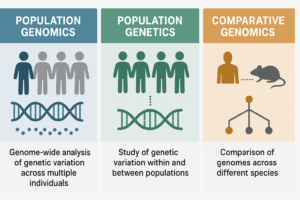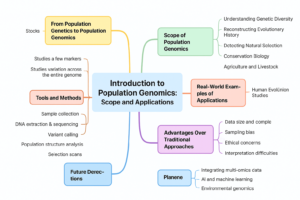- What is Genome?
- Why sequence a genome?
- Application of Genomics
- What is genomic data?
- Population Genomics
- Allele and Genotype Frequencies
- Genomics data sources:
- Top GitHub repositories for Bioinformatics, Genomics and Data analysis
- Seandavi (By Sean Davis)
- crazyhottommy (By Ming Tang)
- kevinblighe (By Kevin Blighe)
What is Genome?
An organism's complete set of DNA is called its genome. Virtually every single cell in the body contains a complete copy of the approximately 3 billion DNA base pairs, or letters, that make up the human genome.
Why sequence a genome?
Learning more about genomes can help us to identify the cause of genetic diseases. Some rare diseases are caused by as little as a single change (variant), like a spelling mistake, in someone’s DNA. Looking at the genome of a person affected by a rare disease can help find which DNA changes might be causing the problem.
In cancer, the tumour cells have developed a different genome to the healthy cells. Comparing the normal and cancer genomes may give clues about ways to treat the cancer. When the genome sequences of patients with the same condition are compared, it is possible to see patterns. These patterns can be put together with health information. Once this is done we may be able to link particular patterns with whether people are likely to become ill and, if so, how severe their illness is likely to be.
Application of Genomics
Genomics is becoming an important part of the healthcare agenda. Genome-based research is already enabling medical researchers to develop improved diagnostics, more effective therapeutic strategies, evidence-based approaches for demonstrating clinical efficacy, and better decision-making tools for patients and providers. Ultimately, it appears inevitable that treatments will be tailored to a patient's particular genomic makeup. Thus, the role of genetics in health care is starting to change profoundly and the first examples of the era of genomic medicine are upon us.
What is genomic data?
As biomedical research projects and large-scale collaborations grow rapidly, the amount of genomic data being generated is also increasing, with roughly 2 to 40 billion gigabytes of data now generated each year. Genomic data science is a field of study that enables researchers to use powerful computational and statistical methods to decode the functional information hidden in DNA sequence. Applied in the context of genomic medicine, these data science tools help researchers and clinicians uncover how differences in DNA affect human health and disease.
Population Genomics
Population genomics is a branch of genomics that studies the genetic variation within and between populations at the whole-genome level. Unlike traditional genetics, which may focus on one or a few genes, population genomics uses large-scale DNA data—often from whole-genome sequencing (WGS), SNP arrays, or other high-throughput methods—to explore the evolutionary, environmental, and health-related aspects of genetic diversity.
In simpler terms:
-
Instead of looking at one individual’s genome, you look at many individuals from a population (or multiple populations) at once.
-
You then compare their genetic differences to uncover patterns of evolution, migration, adaptation, and disease susceptibility.
Key aspects of population genomics:
-
Genome-wide scale – Uses whole-genome sequencing (WGS), SNP arrays, or other high-throughput technologies to assess variation across the entire genome, not just a few genes.
-
Genetic diversity – Measures how much variation exists within and between populations.
-
Evolutionary forces – Identifies signals of natural selection, genetic drift, mutation, gene flow, and recombination.
-
Demographic history – Reconstructs past population sizes, bottlenecks, expansions, and migrations.
-
Adaptation & environment – Finds genes linked to environmental adaptations (e.g., altitude tolerance in Tibetans).
-
Health relevance – Helps pinpoint population-specific disease risk variants, guiding precision medicine.
Example applications:
-
Studying human migration patterns from Africa using genomic data.
-
Tracking how bacteria or viruses evolve resistance to antibiotics.
-
Identifying crop plant genes linked to drought resistance.
-
Understanding genetic adaptations in animals to extreme environments.
From Population Genetics to Population Genomics:
Historically, population genetics studied the genetic variation within and between populations, often using a limited number of genetic markers.
Population genomics is an extension of this concept:
-
Population Genetics → Studies a few markers or loci to understand variation.
-
Population Genomics → Studies variation across the entire genome simultaneously, giving a much more comprehensive view.
For example:
-
In the past, scientists might study five genetic markers to estimate migration between populations.
-
Today, population genomics can study millions of markers spread across the genome, giving highly accurate insights.
Scope of Population Genomics:
Population genomics covers a wide range of research areas and practical applications:
a) Understanding Genetic Diversity
By comparing genomes of individuals from different populations, scientists can:
- Measure genetic variation (e.g., heterozygosity, allele frequency differences).
- Identify population structure (subgroups within populations).
- Detect rare and common genetic variants.
b) Reconstructing Evolutionary History
Population genomics can reveal:
- Ancestral relationships between populations.
- Migration patterns and historical mixing (admixture).
- Evidence of population bottlenecks or expansions.
Example:
Human genome studies have shown migration out of Africa about 60,000–70,000 years ago, followed by admixture with Neanderthals.
c) Detecting Natural Selection
By scanning the genome for regions with unusual patterns of variation, researchers can identify:
- Genes under positive selection (e.g., high-altitude adaptation in Tibetan populations via the EPAS1 gene).
- Genes under balancing selection (maintaining diversity, such as certain immune system genes).
d) Conservation Biology
For endangered species, population genomics helps:
- Estimate effective population size.
- Monitor genetic health.
- Design breeding programs to maintain diversity.
e) Agriculture and Livestock
Population genomics is used to:
- Identify genes linked to yield, disease resistance, or drought tolerance in crops.
- Improve livestock through marker-assisted breeding.
f) Medical and Precision Genomics
By studying genome variation in different human populations:
- We can find population-specific disease risk variants.
- Develop precision medicine approaches tailored to genetic backgrounds.
Tools and Methods in Population Genomics:
Population genomics relies heavily on bioinformatics and statistical tools to analyze large datasets.
Key steps:
- Sample collection – Individuals from one or more populations are sampled.
- DNA extraction & sequencing – Using technologies like Illumina or Oxford Nanopore.
- Variant calling – Identifying SNPs, indels, and structural variants.
- Population structure analysis – Using software like STRUCTURE, ADMIXTURE, or PCA.
- Selection scans – Detecting genomic regions under natural selection (e.g., Fst, iHS, XP-EHH).
- Demographic inference – Estimating historical population sizes, migration rates, etc.
Real-World Examples of Applications:
Human Evolution Studies
-
The Human Genome Diversity Project (HGDP) has mapped variation in over 1,000 individuals from 50+ populations, showing patterns of migration and adaptation.
Disease Studies
-
Genome-wide association studies (GWAS) compare affected and healthy individuals across populations to identify genetic risk factors for diseases like diabetes or heart disease.
Pathogen Genomics
-
Tracking the spread of antibiotic resistance genes in bacteria using population genomics.
-
Monitoring the evolution of viruses such as SARS-CoV-2.
Agricultural Improvement
-
Identifying drought-tolerance genes in maize populations for breeding climate-resilient crops.
Future Directions:
Population genomics is rapidly evolving. Future advancements will likely focus on:
-
Integrating multi-omics data (genomics + transcriptomics + epigenomics).
-
AI and machine learning for pattern recognition in large datasets.
-
Environmental genomics to understand how ecosystems and climate change affect genetic variation.
-
Personalized healthcare based on genomic risk prediction.
Conclusion:
Population genomics is transforming our understanding of life at the genetic level. By studying genomes at the population scale, scientists can uncover deep insights into evolution, adaptation, and health. For B.Tech students, it represents a fascinating blend of biology, data science, and engineering, with applications ranging from conserving biodiversity to advancing human medicine.
As genome sequencing becomes faster and cheaper, population genomics will become a central pillar of biological research in the 21st century.
Download ppt slides: Population_genomics_class_1
Allele and Genotype Frequencies
Download ppt slides: Population_genomics_class2
Genomics data sources:
Recently genomic sequence data have been produced in a exponential way. These data have also created new challenges related to storage, extract information and visualization. Here we will compile different sources of genomics data, analysis tools, and other resources.
update...soon...
Top GitHub repositories for Bioinformatics, Genomics and Data analysis
Seandavi (By Sean Davis)
This Github repository is very good resource for Single Cell RNAseq data analysis, about cancer variants database and information about NCI-GDC (TCGA) data sharing platform. seandavi (Sean Davis)
crazyhottommy (By Ming Tang)
An extensive resources for handling large-scale genomic data and pipelining workflows. Tutorials and pipelines for processing whole-exome, whole-genome DNAseq, RNAseq, single-cell RNAseq, ChIP-seq, and ATACseq data. crazyhottommy (Ming Tang)
kevinblighe (By Kevin Blighe)
Best repository for Bioinformatics and Genomics data analysis and visualization. Curated list of R and Bioconductor packages and data resources for multi-omics tools. Developer of widely used tools: EnhancedVolcano, RegParallel and PCAtools. kevinblighe (Kevin Blighe )
coming more....
Here we will share some exciting startups and innovative ideas and stories related to Biomedicine and healthcare field.
Cambridge Innovation Capital plc and IP Group plc announce the creation of Wellcome Trust Sanger Institute spin-out company, Microbiotica:
Based on ground-breaking research at the Wellcome Trust Sanger Institute into the role of the human microbiome in disease. Goal is to create the world’s leading company focused on microbiome biology and its use in medicine. Cambridge Innovation Capital and IP Group co-lead £8m funding round. Click Here
Matchmaker, matchmaker, find me a grant
Recommendation engine Instrumentl aims to speed grant searching. See detail
Instrumentl: Instrumentl matches scientists to the best grants for their research. Tell us about your project, and we'll let you know exactly which grants you're eligible for. No more Google searching or hunting through clunky databases. For more click here
Here we will share some exciting startups and innovative ideas and stories related to Biomedicine and healthcare field.
Cambridge Innovation Capital plc and IP Group plc announce the creation of Wellcome Trust Sanger Institute spin-out company, Microbiotica:
Based on ground-breaking research at the Wellcome Trust Sanger Institute into the role of the human microbiome in disease. Goal is to create the world’s leading company focused on microbiome biology and its use in medicine. Cambridge Innovation Capital and IP Group co-lead £8m funding round. Click Here
Matchmaker, matchmaker, find me a grant
Recommendation engine Instrumentl aims to speed grant searching. See detail
Instrumentl: Instrumentl matches scientists to the best grants for their research. Tell us about your project, and we'll let you know exactly which grants you're eligible for. No more Google searching or hunting through clunky databases. For more click here


